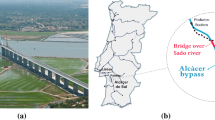Abstract
To obtain accurate finite-element (FE) models for structural health monitoring (SHM), effective modeling techniques are essential. This paper presents the process for establishing a 131-m large transmission tower’s SHM-oriented FE model. Incorporated procedures are appropriate modeling, manual tuning, model updating, and model validation. Through these works, a detailed realistic model that can reproduce all the experimental dynamic characteristics is obtained, and important conclusions about establishing SHM-oriented FE models for large steel pylon structures can be drawn accordingly: (1) it is necessary to model all the bar members using beam or truss elements of equivalent cross sections for local structural behavior exploration; (2) some components (e.g., ladders, steel plates, and rivets) are no influence on the structural overall stiffness, but their contributions to mass cannot be ignored in modeling; (3) the response surface (RS)-based FE model updating method is effective for complicated pylon models; (4) manual tunings are needed to ensure the quality of model updating.










Similar content being viewed by others
References
Fei Q, Zhou H, Han X, Wang J (2012) Structural health monitoring oriented stability and dynamic analysis of a long-span transmission tower-line system. Eng Fail Anal 20:80–87
Saberi MR, Rahai AR, Sanayei M (2016) Steel bridge service life prediction using bootstrap method. Int J Civ Eng. doi:10.1007/s40999-016-0036-z
Fei QG, Xu YL, Ng CL, Wong KY, Chan WY, Man KL (2007) Structural health monitoring oriented finite element model of Tsing Ma Bridge tower. Int J Struct Stab and Dyn 7(4):647–668
Bayraktar A, Sevim B, Altunisik AC, Turker T (2010) Earthquake analysis of reinforced concrete minarets using ambient vibration test results. Struct Design Tall Special Build 19:257–273
Fei QG, Zhang LM, Guo QT (2005) Dynamic finite element model updating based on global information of structures. Chin J Mechanical Eng 18(2):294–296
Deng L, Cai CS (2010) Bridge model updating using response surface method and genetic algorithm. J Bridge Eng 15(5):553–564
Ren WX, Chen HB (2010) Finite element model updating in structural dynamics by using the response surface method. Eng Struct 32(8):2455–2465
Ren WX, Fang SE, Deng MY (2011) Response surface based finite element model updating using structural static responses. J Eng Mech 137(4):248–257
Zhou LR, Yan GR, Ou JP (2013) Response surface method based on radial basis functions for modeling large-scale structures in model updating. Comput Aided Civil Infrastruct Eng 28:210–226
Nanjing Anzheng Software Co., Ltd. (2005). Vibration and dynamic signal acquisition and analysis system (V 7.0) (in Chinese)
Bayraktar A, Altunişik AC, Türker T (2016) Structural Condition Assessment of Birecik Highway Bridge Using Operational Modal Analysis. Int J Civ Eng 14(1):35–46
Yang J, Han J, Li M, Li F, Yang F (2010) Selection of calculation model for steel tubular tower of UHV power transmission line. Power Syst Technol 34(1):1–5 (in Chinese)
Wang H, Yang Y, Li A, Qiao J, Chen Z (2005) Influences of soil-pile-structure interaction on seismic response of long span CFST arch bridge. J Southeast Univ (Natural Sci Edition) 35(3):433–437 (in Chinese)
Ma H, Zhang D (2016) Seismic response of a prestressed concrete wind turbine tower. Int J Civ Eng. doi:10.1007/s40999-016-0029-y
Mashhadiali N, Gholhaki M, Kheyroddin A (2016) Analytical Evaluation of the Vulnerability of Framed Tall Buildings with Steel Plate Shear Wall to Progressive Collapse. Int J Civ Eng. doi:10.1007/s40999-016-0044-z
Hao WH (2005) Applications of ANSYS in Civil Engineering. China water and power press, Beijing (in Chinese)
Li H-N, Shi W-L, Wang G-X, Jia L-G (2005) Simplified models and experimental verification for coupled transmission tower-line system to seismic excitations. J Sound Vib 286(3):569–585
Chen B, Zheng J, Qu W (2009) Control of wind-induced response of transmission tower-line system by using magnetorheological dampers. Int J Struct Stab Dyn 9(4):661–685
Author information
Authors and Affiliations
Corresponding author
Rights and permissions
About this article
Cite this article
Cheng, X., Dong, J., Han, X. et al. Structural Health Monitoring-Oriented Finite-Element Model for a Large Transmission Tower. Int J Civ Eng 16, 79–92 (2018). https://doi.org/10.1007/s40999-016-0069-3
Received:
Revised:
Accepted:
Published:
Issue Date:
DOI: https://doi.org/10.1007/s40999-016-0069-3




